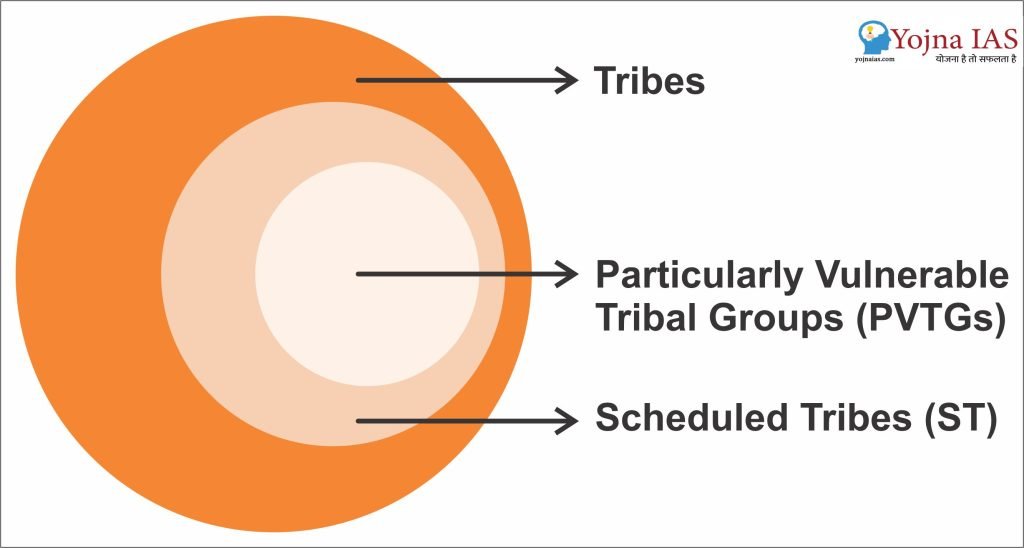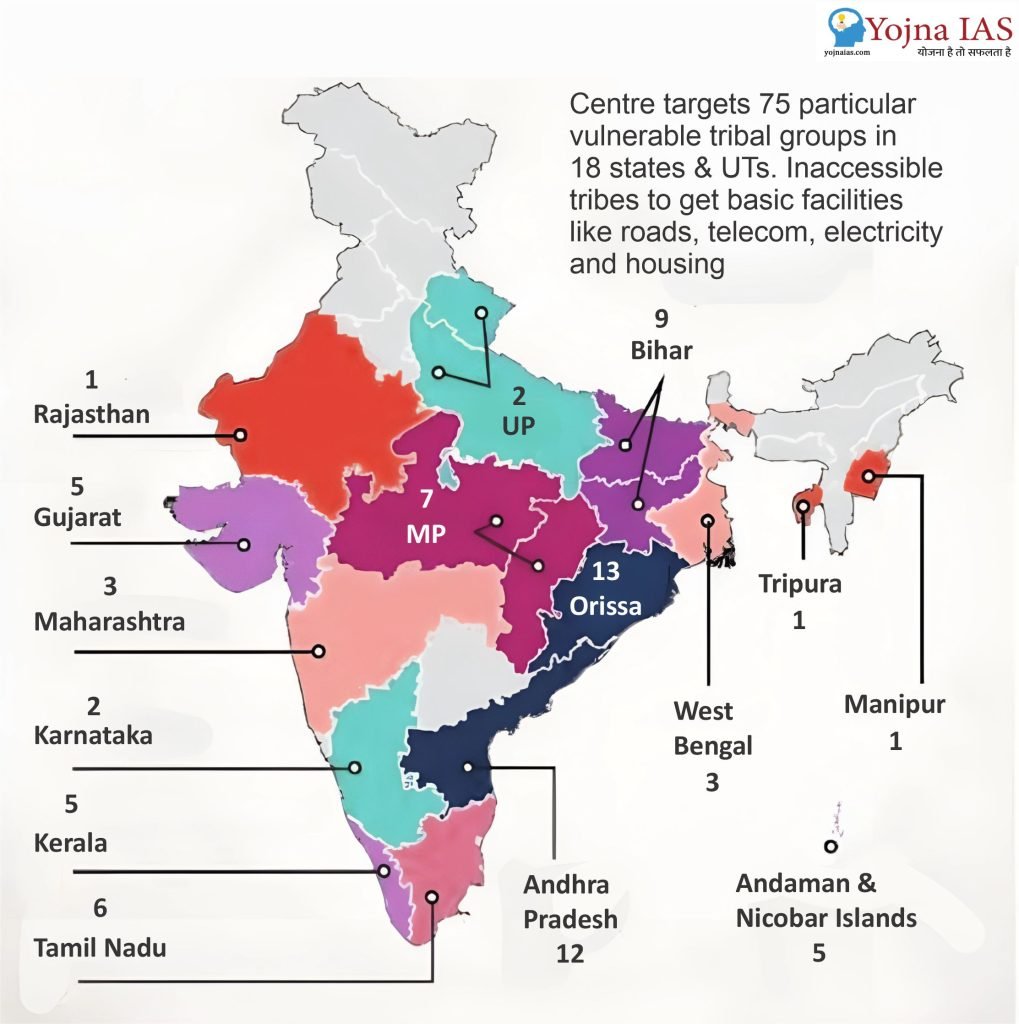08 Feb 2024 Inclusion of new tribes in STs
This article covers ‘Daily Current Affairs’ and the topic details of “Inclusion of new tribes in STs”.This topic is relevant in the “Polity & Governance” section of the UPSC CSE exam.
Why in the News?
The Rajya Sabha has passed the Constitution (STs) Order Amendment Bill 2024 and the Constitution (SCs and STs) Order Amendment Bill 2024, both presented by the Ministry of Tribal Affairs. This paved the path for the inclusion of several new communities on the Odisha STs list, as well as synonyms and phonetic variations of existing tribes on the Andhra Pradesh and Odisha ST lists.
Key provisions of the bill?
- Among the additions were seven Particularly Vulnerable Tribal Groups (PVTGs) (a subset of STs): four in Odisha and three in Andhra Pradesh.
- These PVTGs’ independent names were expressly inserted as synonyms or sub-tribes of communities that were previously on these States’ ST lists.
- In Odisha, PVTG communities include Pauri Bhuyan and Paudi Bhuyan, which are synonyms of the Bhuyan tribe, Chuktia Bhunjia, a sub-tribe of the Bondo Poraja tribe, and Mankidia, a synonym for the Mankirdia tribe.
- In Andhra Pradesh, the PVTG communities used Bondo Porja and Khond Porja as synonyms for the Porja tribe and Konda Savaras as a synonym for the Savara tribe.
- These groups belong to PVTGs and have been included in the scheduled list after 75 years of independence.
- The Bill also included synonyms, phonetic variations, and sub-tribes for at least 8 existing communities on the State’s ST list.
- Furthermore, Odisha’s ST list was increased with the addition of two new communities. These are —
- The Muka Dora community (and synonyms) is in the undivided Koraput District, which encompasses Koraput, Nowrangapur, Rayagada, and Malkangiri districts.
- The Konda Reddy (or synonyms) community.

About PVTGs
- PVTGs are particularly vulnerable among tribal communities. Because of this feature, more developed and assertive tribal groups receive a significant portion of tribal development monies, necessitating the allocation of more funds for PVTG development.
- In this backdrop, the Government of India classified 52 tribal tribes as PVTGs in 1975, based on the Dhebar Commission’s suggestion.
- There are 75 PVTGs out of 705 Scheduled Tribes.
- The PVTGs are scattered across 18 states and one Union Territory (UT) in the country (2011 census).
- Odisha has the highest number of PVTGs (almost 2.5 lakh).
- Characteristics of PVTGs:
-
- Population – stagnant/declining
- Economy – Subsistence level
- Literacy Level – extremely low
- Technology – pre-agricultural

Initiatives for Tribal Groups
- PM Janjati Adivasi Nyaya Maha Abhiyan (PM JANMAN) is an initiative aimed at protecting and nurturing tribal groups, particularly those on the verge of extinction. It covers 75 Particularly Vulnerable Tribal Groups (PVTGs) in 18 states and union territories, covering 22,544 villages in 220 districts. The initiative emphasizes the government’s commitment to uplifting tribal communities, preserving their cultural heritage, and integrating them into mainstream development.
- Viksit Bharat Sankalp Yatra focuses on welfare schemes like sanitation facilities, financial services, electricity connections, food security, healthcare, and clean drinking water.
- The PM PVTG Development Mission program aims to improve the socio-economic status of PVTGs, with a budget of Rs 24000 Crore for Scheduled Tribes. The mission includes providing basic facilities like safe housing, clean drinking water, education, health, nutrition, and better access to roads for backward scheduled tribes.
- Eklavya Model Residential School (EMRS) was established in 1997-98 to provide quality education to Scheduled Tribes (ST) in remote areas. It aims to provide opportunities for high and professional courses, employment, and overall development. Each school has a capacity of 480 students, catering to Class VI to XII. Grants under Article 275(1) of the Constitution support the establishment of these schools. Eklavya Model Day Boarding Schools (EMDBS) are proposed for higher ST population density in identified Sub-Districts.
- “Development of PVTGs” Under the system, state governments submit conservation-and-development (CCD) plans based on their needs.States receive 100% grants-in-aid under the scheme’s terms.
Download Yojna daily current affairs eng med 8th feb 2024
Prelims practice questions
Q1) Consider the following pairs: (UPSC PRELIMS-2013)
Tribe State
1) Limboo (Limbu) Sikkim
2) Karbi Himachal Pradesh
3) Dongaria Kondh Odisha
4) Bonda Tamil Nadu
Which of the above pairs are correctly matched?
a) 1 and 3 only
b) 2 and 4 only
c) 1, 3 and 4 only
d) 1, 2, 3 and 4
ANSWER: A
Q2) Consider the following statements about Particularly Vulnerable Tribal Groups (PVTGs) in India: (UPSC PRELIMS-2019)
1) PVTGs reside in 18 States and one Union Territory.
2) A stagnant or declining population is one of the criteria for determining PVTG status.
3) There are 95 PVTGs officially notified in the country so far.
4) Irular and Konda Reddi tribes are included in the list of PVTGs.
Which of the statements given above are correct?
a) 1, 2 and 3
b) 2, 3 and 4
c) 1, 2 and 4
d) 1, 3 and 4
ANSWER: C
Mains practice questions
Q1) Examine the socio-economic challenges faced by scheduled tribes in contemporary society. What are the key factors contributing to their marginalization, and what strategies can be implemented to address these issues effectively?
Q2) Discuss the conservation and protection of tribal lands and natural resources. How can sustainable development practices be implemented to balance the needs of scheduled tribes with environmental preservation?
I am a content developer and have done my Post Graduation in Political Science. I have given 2 UPSC mains, 1 IB ACIO interview and have cleared UGC NET JRF too.


No Comments